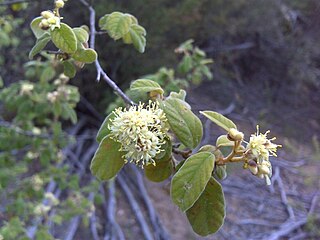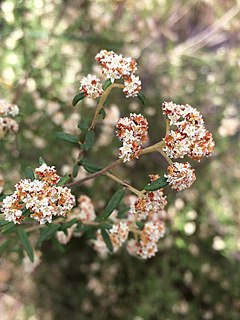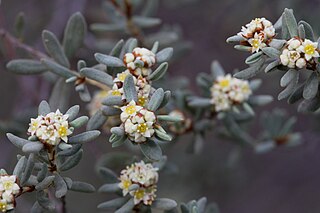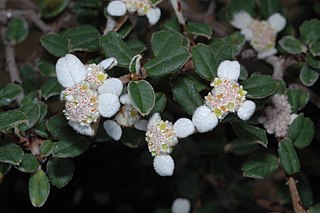
Spyridium globulosum, commonly known as basket bush, is a species of flowering plant in the family Rhamnaceae and is endemic to coastal areas in the south-west of Western Australia. It is a shrub with relatively large leaves and heads of flowers covered with whitish hairs.
Pomaderris crassifolia is a species of flowering plant in the family Rhamnaceae and is endemic to eastern Australia. It is a shrub with hairy young stems, egg-shaped or elliptic leaves, and clusters of cream-coloured or yellow flowers.

Pomaderris subcapitata is a species of flowering plant in the family Rhamnaceae and is endemic to south-eastern continental Australia. It is a shrub with hairy stems, elliptic to egg-shaped leaves and dense clusters of cream-coloured or yellow flowers.

Spyridium scortechinii is a species of flowering plant in the family Rhamnaceae and is endemic to eastern Australia. It is a shrub with egg-shaped to narrowly elliptic leaves, and dense heads of white, woolly-hairy flowers with brown bracts at the base.

Spyridium cinereum, commonly known as tiny spiridium, is a species of flowering plant in the family Rhamnaceae and is endemic to south-eastern continental Australia. It is a low-lying shrub with heart-shaped leaves, the narrower end towards the base, and heads of whitish, shaggy-hairy flowers with brown bracts at the base of the heads.
Spyridium fontis-woodii, commonly known as Woods Well spyridium, is a species of flowering plant in the family Rhamnaceae and is endemic to a small area of Coorong National Park in South Australia. It is a slender shrub with softly-hairy young stems, broadly egg-shaped to broadly heart-shaped leaves with the narrower end towards the base, and head of white to cream-coloured flowers.

Spyridium furculentum, commonly known as forked spyridium, is a species of flowering plant in the family Rhamnaceae and is endemic to a small area of Victoria in Australia. It is a shrub with softly-hairy young stems, Y-shaped leaves, and head of white to cream-coloured flowers.
Spyridium glaucum is a species of flowering plant in the family Rhamnaceae and is endemic to a restricted area of south-western Western Australia. It is an erect or spreading shrub with egg-shaped leaves, and clusters of 3 to 6 rusty-hairy flowers.
Spyridium minutum is a species of flowering plant in the family Rhamnaceae and is endemic to the south of Western Australia. It is an erect or spreading shrub with broadly egg-shaped or heart-shaped leaves, and groups of two or three hairy, white flowers.
Spyridium montanum is a species of flowering plant in the family Rhamnaceae and is endemic to the Stirling Range in the south of Western Australia. It is an erect shrub with elliptic or egg-shaped leaves, and groups of up to ten densely hairy, white or cream-coloured flowers.
Spyridium mucronatum is a species of flowering plant in the family Rhamnaceae and is endemic to the south of Western Australia. It is an erect or spreading shrub usually with narrowly oblong leaves, and dense clusters of up to ten densely hairy, white to yellow flowers.
Spyridium nitidum, commonly known as shining spyridium, is a species of flowering plant in the family Rhamnaceae and is endemic to south-eastern continental Australia. It is an erect, spindly shrub with narrowly elliptic or narrowly egg-shaped leaves with the narrower end towards the base, and heads of hairy, woolly white flowers.
Spyridium × ramosissimum, commonly known as branched spyridium, is a species of flowering plant in the family Rhamnaceae and is endemic to Victoria in Australia. It is a small shrub with woolly-hairy branches, egg-shaped leaves, and crowded heads of hairy flowers with brown bracts.

Spyridium riparium is a species of flowering plant in the family Rhamnaceae and is endemic to the south of Western Australia. It is an erect shrub, usually with narrowly egg-shaped leaves, and clusters of densely hairy, white or cream-coloured flowers.

Spyridium spadiceum is a species of flowering plant in the family Rhamnaceae and is endemic to the south of Western Australia. It is an erect or semi-prostrate shrub with narrowly oblong to oval leaves and heads of hairy flowers with brown bracts at the base.
Pimelea eyrei is a species of flowering plant in the family Thymelaeaceae and is endemic to the southwest of Western Australia. It is an erect shrub with hairy, narrowly elliptic leaves and clusters of densely hairy, white or cream-coloured flowers.

Spyridium stenophyllum is a species of flowering plant in the family Rhamnaceae and is endemic to the south of South Australia. It is a sticky shrub with narrowly Y-shaped leaves, and heads of white to cream-coloured flowers surrounded by densely felty-hairy floral leaves.
Cryptandra distigma is a flowering plant in the family Rhamnaceae and is endemic to inland Western Australia. It is a shrub with oblong or narrowly egg-shaped leaves and clusters of white to cream-coloured, tube-shaped flowers.

Spyridium subochreatum is a species of flowering plant in the family Rhamnaceae and is endemic to southern continental Australia. It is a low shrub with linear to oblong or narrowly egg-shaped leaves, and dense clusters of creamy-white flowers with dark brown, papery bracts at the base.

Spyridium thymifolium, commonly known as thyme-leaved spyridium, is a species of flowering plant in the family Rhamnaceae and is endemic to the south-east of South Australia. It is a small shrub with egg-shaped to almost round leaves, and heads of woolly-hairy flowers.











